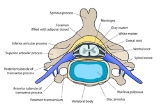
Intervertebral disc
Overview
Vertebral column
In human anatomy, the vertebral column is a column usually consisting of 24 articulating vertebrae, and 9 fused vertebrae in the sacrum and the coccyx. It is situated in the dorsal aspect of the torso, separated by intervertebral discs...
. Each disc forms a cartilaginous joint
Joint
A joint is the location at which two or more bones make contact. They are constructed to allow movement and provide mechanical support, and are classified structurally and functionally.-Classification:...
to allow slight movement of the vertebrae, and acts as a ligament
Ligament
In anatomy, the term ligament is used to denote any of three types of structures. Most commonly, it refers to fibrous tissue that connects bones to other bones and is also known as articular ligament, articular larua, fibrous ligament, or true ligament.Ligament can also refer to:* Peritoneal...
to hold the vertebrae together.
Discs consist of an outer annulus fibrosus
Annulus fibrosus disci intervertebralis
Each intervertebral fibrocartilage is composed, at its circumference, of laminæ of fibrous tissue and fibrocartilage, forming the annulus fibrosus.-Spelling notes:...
, which surrounds the inner nucleus pulposus
Nucleus pulposus
Nucleus pulposus is the jelly-like substance in the middle of the spinal disc. It is the remnant of the notochord . It functions to distribute hydraulic pressure in all directions within each disc under compressive loads. The nucleus pulposus consists of chondrocyte-like cells, collagen fibrils,...
. The annulus fibrosus consists of several layers of fibrocartilage
Fibrocartilage
White fibrocartilage consists of a mixture of white fibrous tissue and cartilaginous tissue in various proportions. It owes its flexibility and toughness to the former of these constituents, and its elasticity to the latter...
. The strong annular fibers contain the nucleus pulposus and distribute pressure evenly across the disc.

